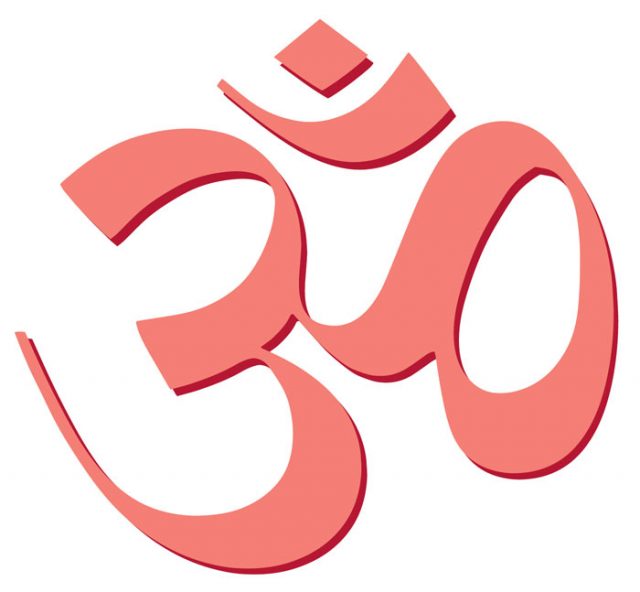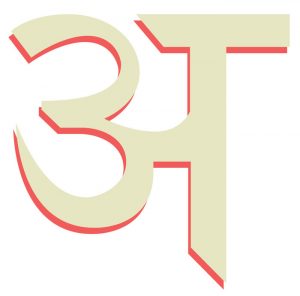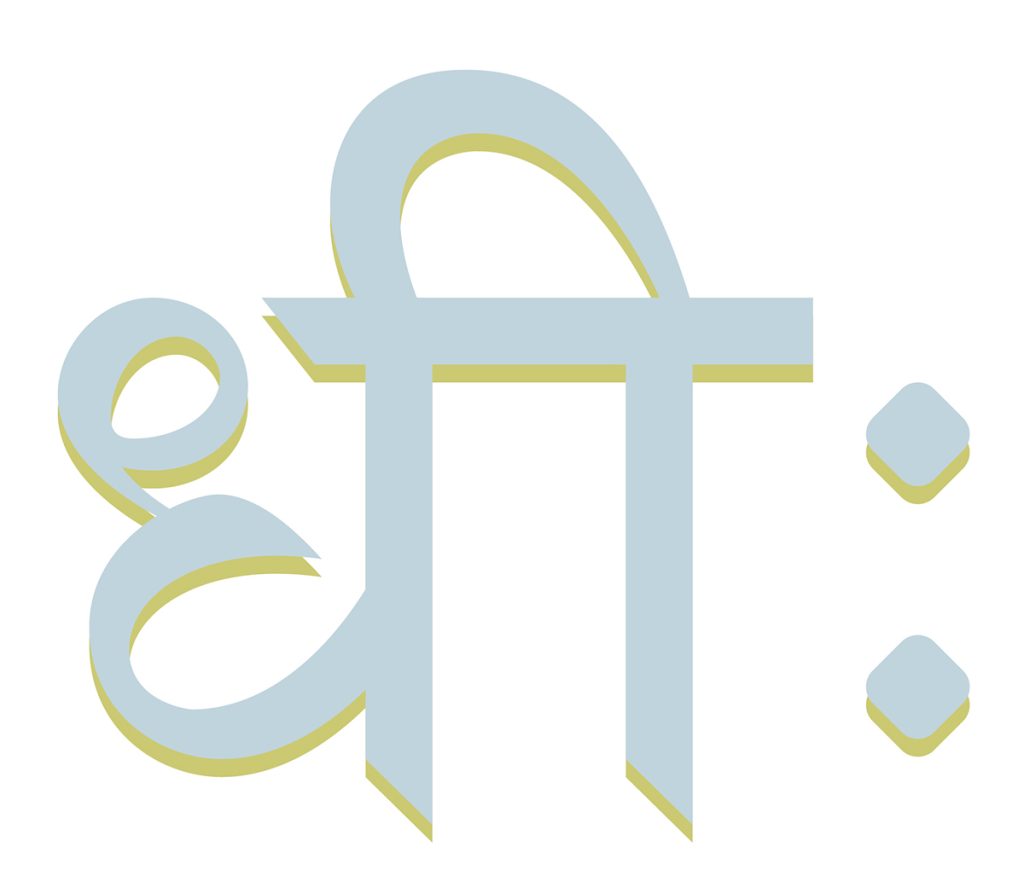In 1971 when I went to college, the University of Rochester, seated on the south bank of Lake Ontario, had a fine medical school, a tall library with a green copper dome, views of the abandoned flour mills along the Genessee River, a club dedicated to bonsai trees—and a language requirement. I’d been reading a late-1960s counterculture curriculum, often smoking grass as I turned the pages: Herman Hesse, Alan Watts, Ram Dass’s Be Here Now, those little Penguin editions of the Upanishads and the Bhagavadgita, and some yoga manuals. Knowing I had to study a language to get through college, I signed up for Sanskrit.
Sanskrit was offered through Rochester’s Religious Studies department. A sharply dressed young scholar, Rama Sharma, taught the basics. He wore heavy green tweed over bright pressed shirts, despite Rochester’s late summer heat and ferocious humidity. We began to labor at a curriculum that had tormented—probably driven mad—Sanskrit students for three generations. It was called “Perry-Whitney-Lanman.” In 1885 Edward D. Perry had published a little book of instruction that condescended to nearly everyone, especially to students. His book assumed that you had wizard capabilities with Greek and Latin or you would not be likely to attempt Sanskrit. Nearly a century after its publication it was still the only primer respected by academics. William Dwight Whitney’s formidable Sanskrit Grammar, published in Leipzig, had come out in 1879—1,316 alarmingly precise little “chapters,” in 550 dense pages. This humorless collection, holding every possible instance of word usage, was to help you figure out points Edward D. Perry did not bother to put in his own book. The third volume, by a Harvard scholar with the aristocratic name Charles Rockwell Lanman, was a Reader with copious notes, published in 1884 in the Harvard Oriental Series.

Trying to get a grip on Sanskrit with stiff, obsolete books that dated from the high era of British colonialism had all of us students baffled. We weren’t just learning Sanskrit; we also had to wrangle with philology (classical scholarship) as 19th-century German academics had developed it. Yet to be studying Sanskrit in 1971 seemed a wild, in fact a revolutionary act. What course of study could lie further from official North American culture? India, we knew, was filled with yogins, ascended masters, smokers of ganja, transvestites, Sufis, mad poets, and a million languages, and we imagined they all had something instrumental to do with Sanskrit. Especially with the Vietnam War raging, the Black Panthers arming, and college students engrossed in drugs, what else would you study? Certainly not Latin. Some of the interest was geopolitical. For 30 years the United States had been fighting nearly every nation in Asia, it seemed. What was all this sustained fighting about? Then there was the legacy of British colonialism: it left young people curious about what traditions might lie under the surface of India, half hidden, waiting to breathe again.
At Christmas break I went to Boston to visit my parents and to check in with the first-rate collection of Indian art downtown at the Museum of Fine Arts. When I returned to Rochester in January 1972, the Sanskrit program had been discontinued. Nobody told me why. I doubt I thought to ask. My troublesome books were in my room. Where Dr. Sharma had gone I had no idea. I never heard of him again. He was my first guru. He taught me at least to read the Sanskrit script.
Fate is a cruel
and proficient potter,
my friend. Forcibly
spinning the wheel
of anxiety, he lifts misfortune
like a cutting tool. Now
having kneaded my heart
like a lump of clay,
he lays it on his
wheel and gives a spin.
What he intends to produce
I cannot tell.—Lady Vidya, trans. Andrew Schelling
Two years later, after a trip to India and Nepal, I made my way to UC Santa Cruz, where Jan Willis recognized enough interest in Buddhist texts among her quite serious students to offer Sanskrit. She had just published her PhD dissertation on Asanga and the Yogacara school of Buddhist thought. Several of her Santa Cruz students already sat zazen at the local Zen center, or went up to Berkeley to see Tarthang Tulku. A group of us signed up enthusiastically. Her course lasted a single quarter before disappearing, even though 20 people had enrolled. I was quite disappointed. Jan mollified my disillusion with the University by looking through Jayadeva’s magisterial poem Gita Govinda with me. We also looked at verses from the Bhagavadgita. There was something I did not look at, though. It was hidden, and I was not alert enough politically to see it.
During three days in mid-July 1971, Secretary of State Henry Kissinger had made a “secret trip” to mainland China and met with Chou en-lai. His visit led to an official invitation for President Richard Nixon, who followed the next February. Nixon met with Mao Tse-tung (that’s how we spelled the names in those days; the pinyin system had not become official yet). The two men normalized relations between the People’s Republic of China and the United States. “Normalize” is one of those words that drives a poet crazy. Here’s something it meant: Prior to 1971, a great deal of attention, and enormous quantities of money, had been directed toward South Asia and South Asian studies—by business, by the military, by the diplomatic corps, by the CIA. Prime Minister Indira Gandhi had been standoffish toward U.S. interests, though, rejecting the assertion that her nation needed American goods in order to prosper. White House tapes exist with Nixon calling her “that bitch,” and Kissinger agreeing with his boss that what India needed was “a good famine.”
There is not a specific day or year you can point to, but from around 1971 forward, funds directed toward studies of India’s cultures or languages were withdrawn. Money for scholars and for South Asian programs in the States began to dry up. Meanwhile, funding for people studying China got flush. Things had been “normalized.” Nixon had forced a huge opportunity. Even if people in college did not see it, American money was opening the way. My friends who went into Chinese studies had graduate school paid for, opportunities to study in Taipei and Beijing, offers of work even before they completed their degrees. The CIA approached a couple of my friends who really just wanted to translate Tang dynasty poets. The Agency needed folk who could speak, or at least read newspapers in, Mandarin or Cantonese. As did international banks, transport companies, the diplomatic corps, and the military.
And India? With the funds to study and travel being cut, what kept India alive in North American consciousness?
Not much that was academic. Ravi Shankar. Bedspreads with trippy paisley designs. The Beatles. The hashish trail from Kabul to Kathmandu. Head shops in the cities. Incense, Punjabi sandals, little bronze Buddhas, sandalwood soap. When George Harrison took up the sitar and named Ravi Shankar his teacher it boosted a subculture of India tradition that became part of late ’60s, early ’70s life in Europe and North America. Yoga. Ayurvedic medicine. All this excitement, little of it matched by academic, media, cultural, or diplomatic attention. You could say that official attention to India was swamped by counterculture diplomacy.

A few popular books on yoga were around. So were Alan Watts, and Alexandra David Neel (published by City Lights), and suddenly Shambhala Publications opened shop in Berkeley. Within a few years you could read Lama Govinda, Chögyam Trungpa, sGam.po.pa, and a lot of colorful titles on mandalas, Tibet, mantras, bread-baking at Tassajara Zen Mountain Center, or accounts of Ramakrishna, Paramahansa Yogananda, and Ramana Maharshi.
Strangely, in this modest presentation of literature from India, there was really no poetry. I initially went to Sanskrit for religious texts; so did everyone else willing to put up with a punishing language curriculum. Gita, Upanishads, Yoga Sutra, Buddhist commentaries. (Most of the Buddhist material coming out was actually from Chinese, Japanese, or Tibetan sources; notable exceptions were the books of Edward Conze, and some of Alan Watts’s regular ruminations on Pacifica Radio.) This lack of poetry was understandable: nothing like haiku, or Tang dynasty recluses, was around in good editions; no one from India like Han Shan, Su Tung-po, Matsuo Basho, or Lady Murasaki. There were no poetry translations from India that excited anyone. Not just translations from Sanskrit, but translations from the hundreds of other Indian languages. (A few numbers: India’s 2001 census identified 1,721 “mother tongues” with separate grammatical structures, of which 122 are “major languages,” meaning they have more than 10,000 native speakers; in 2011 the number of “major languages” remained steady at 122. Thirty Indian languages have more than a million speakers.)
What would be the incentive to study any of these? In those days there wasn’t much Indian poetry worth reading, not for an English-only reader. Why would a poet consider learning the language of Gujarat (population greater than the British Isles), or Marathi? You could look into Tagore, but that was pretty insipid. A fine Bengali poet, people said, but his biblical-sounding paragraphs sure didn’t sing in English.
When I went into Sanskrit finally and decisively—at Berkeley in the late 1970s—Robert Goldman and Sally Sutherland were developing a new curriculum, and had written a textbook with a fine, more alluring title, Devavanipravesika: An Introduction to the Sanskrit Language (literally, “Introduction to Speech of the Gods”). The smartest gesture of this book was to bypass Western linguistics and go straight to the people who had done exacting, gorgeous linguistics work at the beginning: the Sanskrit grammarians. Panini was the first great linguist we know of. Though early India’s dates are notoriously elusive, scholars have placed Panini close to the time of Shakyamuni Buddha, in the 4th or 5th century BCE.
No one visible up ahead,
no one approaches
from behind.
Not a footprint on the road.
Am I alone?
This much is clear—the path the ancient
poets opened
is choked with brush,
and I’ve long since left
the public thoroughfare.—Dharmakirti, trans. Andrew Schelling
At Berkeley I stumbled on what seemed to be an entirely unknown classical tradition. A tradition practically untouched by English or American-speaking poets capable of making its verse come alive. What I found were Sanskrit poems that are secular, lighthearted, fleet-footed, playful, sad, musical. They are vivid, humorous, full of riddles, puzzles, folk song; some are mantras themselves. All of them have a deep spiritual bent. Mostly they got written when Buddhism was thriving in India, and if you begin to look closely, you’ll see that many are in fact tiny sutras with lightning-sharp glimpses of impermanence, emptiness, kindness. In fact, renowned siddhas, acharyas, and yogins had written poetry alongside big metaphysical works: Dharmakirti (Buddhist logician), Abhinavagupta (Kashmiri Shaivism’s great scholar), Bhartrihari (mystical grammarian). Quite unwittingly, mostly alone, I sort of sat down atop a large dictionary with a couple of bramble-patch grammar books and set to work. I’ve been doing it off and on ever since.
Eventually I located a few others who had done related work. Deben Bhattacharya, whom I got to know toward the end of his life, was a kind, gentle Bengali who divided his year between Calcutta and Paris. He made clear, no-nonsense translations of vernacular poetry that he knew from his upbringing in Bengal. He also did recordings of Bengali folk music (and films); those probably helped his ear. A. K. Ramanujan had a popular little title, Speaking of Siva, which is still in print. Those poems are full of weird upside-down language and verses that are quite surrealistic. They burrow into your head. When you read them you recognize that one thousand years ago India could do surrealism as good as 20th-century France: “Riding the blue sapphire mountains / wearing moonstone for slippers / blowing long horns / O Siva / when shall I crush you / on my pitcher breasts.”
In 1977, the American poet W. S. Merwin, working with Sanskrit scholar J. Moussaie Masson, released a book of translations with the unexciting title Sanskrit Love Poetry. The Berkeley publisher Jack Shoemaker reissued it several years later with a bright, up-to-date cover and a more vivid title, The Peacock’s Egg: Love Poems from India. This book showed me that you could make good American poems out of Sanskrit originals. It was the book that persuaded me that Sanskrit poetry was, in fact, a peerless tradition. Nothing else in the world resembles it. It did not have to be translated the way the British colonists did. Those old translations make the tradition sound fatigued, ornate, and overfed. The originals, though, are tiny points of enlightenment.

Once I asked the Telugu scholar Velcheru Narayana Rao why the British Raj had made such execrable translations. “They thought Sanskrit a dead language,” he said with a tender smile. “So they translated it into dead English.”
The same holds for most of the Indian Buddhist material, the sutras, tantras, philosophical treatises. It’s like they are patiently waiting for some good translators to provide them with what the 20th-century German Jewish philosopher Walter Benjamin called “the afterlife” of a work of literature. They are filled with good poetry, which is to say language echoing with overtones and undertones, not just literal meanings. I like to picture the Perfection of Wisdom books looking around, a slightly unreadable smile on their lips, for the right translators. That’s what it felt like when I found the poetry of Sanskrit. The poems had waited patiently; when someone showed up they wouldn’t let go.
♦
Poems from Dropping the Bow: Poems of Ancient India by Andrew Schelling, White Pine Press, 2008. Reprinted with permission.
Thank you for subscribing to Tricycle! As a nonprofit, we depend on readers like you to keep Buddhist teachings and practices widely available.
